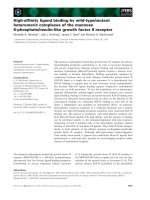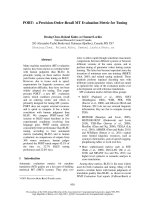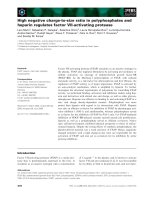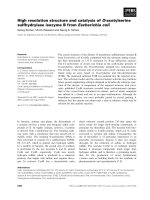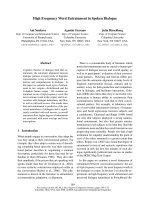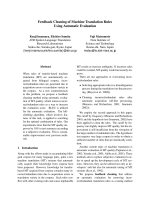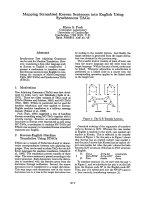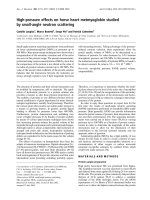Báo cáo khoa học: "High Precision Treebanking — Blazing Useful Trees Using POS Information" pot
Bạn đang xem bản rút gọn của tài liệu. Xem và tải ngay bản đầy đủ của tài liệu tại đây (294.74 KB, 8 trang )
Proceedings of the 43rd Annual Meeting of the ACL, pages 330–337,
Ann Arbor, June 2005.
c
2005 Association for Computational Linguistics
High Precision Treebanking
— Blazing Useful Trees Using POS Information —
Takaaki Tanaka,
†
Francis Bond,
†
Stephan Oepen,
‡
Sanae Fujita
†
†
{takaaki, bond, fujita}@cslab.kecl.ntt.co.jp
‡
†
NTT Communication Science Laboratories, Nippon Telegraph and Telephone Corporation
‡
Universitetet i Oslo and CSLI, Stanford
Abstract
In this paper we present a quantitative
and qualitative analysis of annotation in
the Hinoki treebank of Japanese, and in-
vestigate a method of speeding annotation
by using part-of-speech tags. The Hinoki
treebank is a Redwoods-style treebank of
Japanese dictionary definition sentences.
5,000 sentences are annotated by three dif-
ferent annotators and the agreement evalu-
ated. An average agreement of 65.4% was
found using strict agreement, and 83.5%
using labeled precision. Exploiting POS
tags allowed the annotators to choose the
best parse with 19.5% fewer decisions.
1 Introduction
It is important for an annotated corpus that the mark-
up is both correct and, in cases where variant anal-
yses could be considered correct, consistent. Con-
siderable research in the field of word sense disam-
biguation has concentrated on showing that the an-
notation of word senses can be done correctly and
consistently, with the normal measure being inter-
annotator agreement (e.g. Kilgariff and Rosenzweig,
2000). Surprisingly, few such studies have been car-
ried out for syntactic annotation, with the notable
exceptions of Brants et al. (2003, p 82) for the Ger-
man NeGra Corpus and Civit et al. (2003) for the
Spanish Cast3LB corpus. Even such valuable and
widely used corpora as the Penn TreeBank have not
been verified in this way.
We are constructing the Hinoki treebank as part of
a larger project in cognitive and computational lin-
guistics ultimately aimed at natural language under-
standing (Bond et al., 2004). In order to build the ini-
tial syntactic and semantic models, we are treebank-
ing the dictionary definition sentences of the most
familiar 28,000 words of Japanese and building an
ontology from the results.
Arguably the most common method in building a
treebank still is manual annotation, annotators (often
linguistics students) marking up linguistic properties
of words and phrases. In some semi-automated tree-
bank efforts, annotators are aided by POS taggers or
phrase-level chunkers, which can propose mark-up
for manual confirmation, revision, or extension. As
computational grammars and parsers have increased
in coverage and accuracy, an alternate approach has
become feasible, in which utterances are parsed and
the annotator selects the best parse Carter (1997);
Oepen et al. (2002) from the full analyses derived
by the grammar.
We adopted the latter approach. There were four
main reasons. The first was that we wanted to de-
velop a precise broad-coverage grammar in tandem
with the treebank, as part of our research into natu-
ral language understanding. Treebanking the output
of the parser allows us to immediately identify prob-
lems in the grammar, and improving the grammar
directly improves the quality of the treebank in a mu-
tually beneficial feedback loop (Oepen et al., 2004).
The second reason is that we wanted to annotate to a
high level of detail, marking not only dependency
and constituent structure but also detailed seman-
tic relations. By using a Japanese grammar (JACY:
Siegel and Bender, 2002) based on a monostratal
theory of grammar (HPSG: Pollard and Sag, 1994)
we could simultaneously annotate syntactic and se-
mantic structure without overburdening the annota-
330
tor. The third reason was that we expected the use
of the grammar to aid in enforcing consistency —
at the very least all sentences annotated are guaran-
teed to have well-formed parses. The flip side to this
is that any sentences which the parser cannot parse
remain unannotated, at least unless we were to fall
back on full manual mark-up of their analyses. The
final reason was that the discriminants can be used
to update the treebank when the grammar changes,
so that the treebank can be improved along with the
grammar. This kind of dynamic, discriminant-based
treebanking was pioneered in the Redwoods tree-
bank of English (Oepen et al., 2002), so we refer
to it as Redwoods-style treebanking.
In the next section, we give some more details
about the Hinoki Treebank and the data used to eval-
uate the parser (§ 2). This is followed by a brief dis-
cussion of treebanking using discriminants (§ 3), and
an extension to seed the treebanking using existing
markup (§ 4). Finally we present the results of our
evaluation (§ 5), followed by some discussion and
outlines for future research.
2 The Hinoki Treebank
The Hinoki treebank currently consists of around
95,000 annotated dictionary definition and example
sentences. The dictionary is the Lexeed Semantic
Database of Japanese (Kasahara et al., 2004), which
consists of all words with a familiarity greater than
or equal to five on a scale of one to seven. This
gives 28,000 words, divided into 46,347 different
senses. Each sense has a definition sentence and
example sentence written using only these 28,000
familiar words (and some function words). Many
senses have more than one sentence in the definition:
there are 81,000 defining sentences in all.
The data used in our evaluation is taken from the
first sentence of the definitions of all words with a
familiarity greater than six (9,854 sentences). The
Japanese grammar JACY was extended until the
coverage was over 80% (Bond et al., 2004).
For evaluation of the treebanking we selected
5,000 of the sentences that could be parsed, and di-
vided them into five 1,000 sentence sets (A–E). Def-
inition sentences tend to vary widely in form de-
pending on the part of speech of the word being de-
fined — each set was constructed with roughly the
same distribution of defined words, as well as hav-
ing roughly the same length (the average was 9.9,
ranging from 9.5–10.4).
A (simplified) example of an entry (Sense 2 of
k
¯
aten “curtain: any barrier to communica-
tion or vision”), and a syntactic view of its parse are
given in Figure 1. There were 6 parses for this def-
inition sentence. The full parse is an HPSG sign,
containing both syntactic and semantic information.
A view of the semantic information is given in Fig-
ure 2
1
.
UTTERANCE
NP
VP N
PP V
NP
DET N CASE-P
aru monogoto o kakusu mono
a certain stuff AC C hide thing
Curtain
2
: “a thing that hides something”
Figure 1: Syntactic View of the Definition of
2
k
¯
aten “curtain”
h
0
, x
2
{h
0
: proposition(h
5
)
h
1
: aru(e
1
, x
1
, u
0
) “a certain”
h
1
: monogoto(x
1
) “stuff”
h
2
: u
def(x
1
, h
1
, h
6
)
h
5
: kakusu(e
2
, x
2
, x
1
) “hide”
h
3
: mono(x
2
) “thing”
h
4
: u
def(x
2
, h
3
, h
7
)}
Figure 2: Semantic View of the Definition of
2
k
¯
aten “curtain”
The semantic view shows some ambiguity has
been resolved that is not visible in the purely syn-
tactic view. In Japanese, relative clauses can have
gapped and non-gapped readings. In the gapped
reading (selected here), mono “thing” is the sub-
ject of kakusu “hide”. In the non-gapped read-
ing there is some unspecified relation between the
thing and the verb phrase. This is similar to the dif-
ference in the two readings of the day he knew in En-
glish: “the day that he knew about” (gapped) vs “the
day on which he knew (something)” (non-gapped).
1
The semantic representation used is Minimal Recursion Se-
mantics (Copestake et al., Forthcoming). The figure shown here
hides some of the detail of the underspecified scope.
331
Such semantic ambiguity is resolved by selecting the
correct derivation tree that includes the applied rules
in building the tree, as shown in Figure 3. In the next
phase of the Hinoki project, we are concentrating on
acquiring an ontology from these semantic represen-
tations and using it to improve the parse selection
(Bond et al., 2004).
3 Treebanking Using Discriminants
Selection among analyses in our set-up is done
through a choice of elementary discriminants, basic
and mostly independent contrasts between parses.
These are (relatively) easy to judge by annotators.
The system selects features that distinguish between
different parses, and the annotator selects or rejects
the features until only one parse is left. In a small
number of cases, annotation may legitimately leave
more than one parse active (see below). The system
we used for treebanking was the [incr tsdb()] Red-
woods environment
2
(Oepen et al., 2002). The num-
ber of decisions for each sentence is proportional
to the log of the number of parses. The number of
decisions required depends on the ambiguity of the
parses and the length of the input. For Hinoki, on av-
erage, the number of decisions presented to the an-
notator was 27.5. However, the average number of
decisions needed to disambiguate each sentence was
only 2.6, plus an additional decision to accept or re-
ject the selected parses
3
. In general, even a sentence
with 100 parses requires only around 5 decisions and
1,000 parses only around 7 decisions. A graph of
parse results versus number of decisions presented
and required is given in Figure 6.
The primary data stored in the treebank is the
derivation tree: the series of rules and lexical items
the parser used to construct the parse. This, along
with the grammar, can be combined to rebuild the
complete HPSG sign. The annotators task is to se-
lect the appropriate derivation tree or trees. The pos-
sible derivation trees for
2
k
¯
aten “curtain”
are shown in Figure 3. Nodes in the trees indicate
applied rules, simplified lexical types or words. We
2
The [incr tsdb()] system, Japanese and English grammars
and the Redwoods treebank of English are available from the
Deep Linguistic Processing with HPSG Initiative (DELPH-IN:
/>3
This average is over all sentences, even non-ambiguous
ones, which only require a decision as to whether to accept or
reject.
will use it as an example to explain the annotation
process. Figure 3 also displays POS tag from a sep-
arate tagger, shown in typewriter font.
4
This example has two major sources of ambiguity.
One is lexical: aru “a certain/have/be” is ambigu-
ous between a reading as a determiner “a certain”
(det-lex) and its use as a verb of possession “have”
(aru-verb-lex). If it is a verb, this gives rise to
further structural ambiguity in the relative clause, as
discussed in Section 2. Reliable POS tags can thus
resolve some ambiguity, although not all.
Overall, this five-word sentence has 6 parses. The
annotator does not have to examine every tree but is
instead presented with a range of 9 discriminants, as
shown in Figure 4, each local to some segment of
the utterance (word or phrase) and thus presenting a
contrast that can be judged in isolation. Here the first
column shows deduced status of discriminants (typ-
ically toggling one discriminant will rule out oth-
ers), the second actual decisions, the third the dis-
criminating rule or lexical type, the fourth the con-
stituent spanned (with a marker showing segmenta-
tion of daughters, where it is unambiguous), and the
fifth the parse trees which include the rule or lexical
type.
D A
Rules /
Lexical Types
Subtrees /
Lexical items
Parse
Trees
? ? rel-cl-sbj-gap 2,4,6
? ? rel-clause
1,3,5
- ? rel-cl-sbj-gap
3,4
- ? rel-clause
5,6
+ ? hd-specifier
1,2
? ? subj-zpro
2,4,6
- ? subj-zpro
5,6
- ? aru-verb-lex
3–6
+ + det-lex
1,2
+: positive decision
-: negative decision
?: indeterminate / unknown
Figure 4: Discriminants (marked after one is se-
lected). D : deduced decisions, A : actual decisions
After selecting a discriminant, the system recal-
culates the discriminant set. Those discriminants
which can be deduced to be incompatible with the
decisions are marked with ‘−’, and this information
is recorded. The tool then presents to the annotator
4
The POS markers used in our experiment are from the
ChaSen POS tag set (.
jp/), we show simplified transliterated tag names.
332
NP-frag
rel-cl-sbj-gap
hd-complement N
hd-complement V
hd-specifier
DET N CASE-P
adnominal noun particle verb noun
a certain thing ACC hide thing
Tree #1
NP-frag
rel-clause
hd-complement N
hd-complement subj-zpro
hd-specifier V
DET N CASE-P
adnominal noun particle verb noun
a certain thing ACC hide thing
Tree #2
NP-frag
rel-cl-sbj-gap
hd-complement N
hd-complement V
rel-cl-sbj-gap
V N CASE-P
verb noun particle verb noun
exist thing ACC hide thing
Tree #3
NP-frag
rel-clause
hd-complement N
hd-complement subj-zpro
rel-cl-sbj-gap V
V N CASE-P
verb noun particle verb noun
exist thing ACC hide thing
Tree #4
NP-frag
rel-cl-sbj-gap
hd-complement N
hd-complement V
rel-clause
subj-zpro
V N CASE-P
verb noun particle verb noun
exist thing ACC hide thing
Tree #5
NP-frag
rel-clause
hd-complement N
hd-complement subj-zpro
rel-clause V
subj-zpro
V N CASE-P
verb noun particle verb noun
exist thing ACC hide thing
Tree #6
Figure 3: Derivation Trees of the Definition of
2
k
¯
aten “curtain”
only those discriminants which still select between
the remaining parses, marked with ‘?’.
In this case the desired parse can be selected with
a minimum of two decisions. If the first decision is
that
aru is a determiner (det-lex), it elimi-
nates four parses, leaving only three discriminants
(corresponding to trees #1 and #2 in Figure 3) to be
decided on in the second round of decisions. Select-
ing mono “thing” as the gapped subject of
kakusu “hide” (rel-cl-sbj-gap) resolves the parse
forest to the single correct derivation tree #1 in Fig-
ure 3.
The annotator also has the option of leaving some
ambiguity in the treebank. For example, the verbal
noun
¯
opun “open” is defined with the sin-
gle word
aku/hiraku “open”. This word how-
ever, has two readings: aku which is intransitive and
hiraku which is transitive. As
¯
opun “open”
can be either transitive or intransitive, both parses
are in fact correct! In such cases, the annotators were
instructed to leave both parses.
Finally, the annotator has the option of rejecting
all the parses presented, if none have the correct syn-
tax and semantics. This decision has to be made
even for sentences with a unique parse.
4 Using POS Tags to Blaze the Trees
Sentences in the Lexeed dictionary were already
part-of-speech tagged so we investigated exploiting
this information to reduce the number of decisions
the annotators had to make. More generally, there
are many large corpora with a subset of the infor-
mation we desire already available. For example,
the Kyoto Corpus (Kurohashi and Nagao, 2003) has
part of speech information and dependency informa-
tion, but not the detailed information available from
an HPSG analysis. However, the existing informa-
tion can be used to blaze
5
trees in the parse forest:
that is to select or reject certain discriminants based
on existing information.
Because other sources of information may not be
entirely reliable, or the granularity of the informa-
tion may be different from the granularity in our
5
In forestry, to blaze is to mark a tree, usually by painting
and/or cutting the bark, indicating those to be cut or the course
of a boundary, road, or trail.
333
treebank, we felt it was important that the blazes
be defeasible. The annotator can always reject the
blazed decisions and retag the sentence.
In [incr tsdb()], it is currently possible to blaze us-
ing POS information. The criteria for the blazing de-
pend on both the grammar used to make the treebank
and the POS tag set. The system matches the tagged
POS against the grammar’s lexical hierarchy, using a
one-to-many mapping of parts of speech to types of
the grammar and a subsumption-based comparison.
It is thus possible to write very general rules. Blazes
can be positive to accept a discriminant or negative
to reject it. The blaze markers are defined to be a
POS tag, and then a list of lexical types and a score.
The polarity of the score determines whether to ac-
cept or reject. The numerical value allows the use
of a threshold, so that only those markers whose ab-
solute value is greater than a threshold will be used.
The threshold is currently set to zero: all blaze mark-
ers are used.
Due to the nature of discriminants, having two
positively marked but competing discriminants for
the same word will result in no trees satisfying the
conditions. Therefore, it is important that only neg-
ative discriminants should be used for more general
lexical types.
Hinoki uses 13 blaze markers at present, a sim-
plified representation of them is shown in Figure 5.
E.g. if verb-aux, v-stem-lex, -1.0 was a blaze
marker, then any sentence with a verb that has two
non-auxiliary entries (e.g. hiraku/aku vt and vi)
would be eliminated. The blaze set was derived from
a conservative inspection of around 1,000 trees from
an earlier round of annotation of similar data, identi-
fying high-frequency contrasts in lexical ambiguity
that can be confidently blazed from the POS granu-
larity available for Lexeed.
POS tags Lexical Types in the Grammar Score
verb-aux v-stem-lex −1.0
verb-main aspect-stem-lex −1.0
noun verb-stem-lex −1.0
adnominal noun
mod-lex-l 0.9
det-lex 0.9
conjunction n conj-p-lex 0.9
v-coord-end-lex 0.9
adjectival-noun noun-lex −1.0
Figure 5: Some Blaze Markers used in Hinoki
For the example shown in Figures 3 and 4, the
blaze markers use the POS tagging of the determiner
aru to mark it as det-lex. This eliminates
four parses and six discriminants leaving only three
to be presented to the annotator. On average, mark-
ing blazes reduced the average number of blazes pre-
sented per sentence from 27.5 to 23.8 (a reduction
of 15.6%). A graphical view of number of discrimi-
nants versus parse ambiguity is shown in Figure 6.
5 Measuring Inter-Annotator Agreement
Lacking a task-oriented evaluation scenario at this
point, inter-annotator agreement is our core measure
of annotation consistency in Hinoki. All trees (and
associated semantics) in Hinoki are derived from a
computational grammar and thus should be expected
to demonstrate a basic degree of internal consis-
tency. On the other hand, the use of the grammar
exposes large amounts of ambiguity to annotators
that might otherwise go unnoticed. It is therefore not
a priori clear whether the Redwoods-style approach
to treebank construction as a general methodology
results in a high degree of internal consistency or a
comparatively low one.
α – β β – γ γ – α Average
Parse Agreement 63.9 68.2 64.2 65.4
Reject Agreement
4.8 3.0 4.1 4.0
Parse Disagreement 17.5 19.2 17.9 18.2
Reject Disagreement
13.7 9.5 13.8 12.4
Table 1: Exact Match Inter-annotator Agreement
Table 1 quantifies inter-annotator agreement in
terms of the harshest possible measure, the propor-
tion of sentences for which two annotators selected
the exact same parse or both decided to reject all
available parses. Each set was annotated by three
annotators (α, β, γ). They were all native speakers
of Japanese with a high score in a Japanese profi-
ciency test (Amano and Kondo, 1998) but no lin-
guistic training. The average annotation speed was
50 sentences an hour.
In around 19 per cent of the cases annotators
chose to not fully disambiguate, keeping two or even
three active parses; for these we scored
i
j
, with j be-
ing the number of identical pairs in the cross-product
of active parses, and i the number of mismatches.
One annotator keeping {1, 2, 3}, for example, and
another {3, 4} would be scored as
1
6
. In addition to
334
leaving residual ambiguity, annotators opted to re-
ject all available parses in some eight per cent of
cases, usually indicating opportunities for improve-
ment of the underlying grammar. The Parse Agree-
ment figures (65.4%) in Table 1 are those sentences
where both annotators chose one or more parses,
and they showed non-zero agreement. This figure
is substantially above the published figure of 52%
for NeGra Brants et al. (2003). Parse Disagreement
is where both chose parses, but there was no agree-
ment. Reject Agreement shows the proportion of
sentences for which both annotators found no suit-
able analysis. Finally Reject Disagreement is those
cases were one annotator found no suitable parses,
but one selected one or more.
The striking contrast between the comparatively
high exact match ratios (over a random choice base-
line of below seven per cent; κ = 0.628) and the low
agreement between annotators on which structures
to reject completely suggests that the latter type of
decision requires better guidelines, ideally tests that
can be operationalized.
To obtain both a more fine-grained measure and
also be able to compare to related work, we com-
puted a labeled precision f-score over derivation
trees. Note that our inventory of labels is large,
as they correspond in granularity to structures of
the grammar: close to 1,000 lexical and 120 phrase
types. As there is no ‘gold’ standard in contrasting
two annotations, our labeled constituent measure F
is the harmonic mean of standard labeled precision
P (Black et al., 1991; Civit et al., 2003) applied in
both ‘directions’: for a pair of annotators α and β, F
is defined as:
F =
2P (α, β)P (β, α)
P (α, β) + P (β, α)
As found in the discussion of exact match inter-
annotator agreement over the entire treebank, there
are two fundamentally distinct types of decisions
made by annotators, viz. (a) elimination of unwanted
ambiguity and (b) the choice of keeping at least one
analysis or rejecting the entire item. Of these, only
(b) applies to items that are assigned only one parse
by the grammar, hence we omit unambiguous items
from our labeled precision measures (a little more
than twenty per cent of the total) to exclude trivial
agreement from the comparison. In the same spirit,
to eliminate noise hidden in pairs of items where one
or both annotators opted for multiple valid parses,
we further reduced the comparison set to those pairs
where both annotators opted for exactly one active
parse. Intersecting both conditions for pairs of an-
notators leaves us with subsets of around 2,500 sen-
tences each, for which we record F values ranging
from 95.1 to 97.4, see Table 2. When broken down
by pairs of annotators and sets of 1,000 items each,
which have been annotated in strict sequential order,
F scores in Table 2 confirm that: (a) inter-annotator
agreement is stable, all three annotators appear to
have performed equally (well); (b) with growing ex-
perience, there is a slight increase in F scores over
time, particularly when taking into account that set
E exhibits a noticeably higher average ambiguity
rate (1208 parses per item) than set D (820 aver-
age parses); and (c) Hinoki inter-annotator agree-
ment compares favorably to results reported for the
German NeGra (Brants, 2000) and Spanish Cast3LB
(Civit et al., 2003) treebanks, both of which used
manual mark-up seeded from automated POS tag-
ging and chunking.
Compared to the 92.43 per cent labeled F score
reported by Brants (2000), Hinoki achieves an ‘er-
ror’ (i.e. disagreement) rate of less than half, even
though our structures are richer in information and
should probably be contrasted with the ‘edge label’
F score for NeGra, which is 88.53 per cent. At
the same time, it is unknown to what extent results
are influenced by differences in text genre, i.e. av-
erage sentence length of our dictionary definitions
is noticeably shorter than for the NeGra newspaper
corpus. In addition, our measure is computed only
over a subset of the corpus (those trees that can be
parsed and that had multiple parses which were not
rejected). If we recalculate over all 5,000 sentences,
including rejected sentences (F measure of 0) and
those with no ambiguity (F measure of 1) then the
average F measure is 83.5, slightly worse than the
score for NeGra. However, the annotation process
itself identifies which the problematic sentences are,
and how to improve the agreement: improve the
grammar so that fewer sentences need to be rejected
and then update the annotation. The Hinoki treebank
is, by design, dynamic, so we expect to continue to
improve the grammar and annotation continuously
over the project’s lifetime.
335
Test α – β β – γ γ – α Average
Set
# F # F # F F
A 507 96.03 516 96.22 481 96.24 96.19
B 505 96.79 551 96.40 511 96.57 96.58
C
489 95.82 517 95.15 477 95.42 95.46
D
454 96.83 477 96.86 447 97.40 97.06
E
480 95.15 497 96.81 484 96.57 96.51
2435 96.32 2558 96.28 2400 96.47 96.36
Table 2: Inter-Annotator Agreement as Mutual Labeled Precision F-Score
Test Annotator Decisions Blazed
Set α β γ Decisions
A 2,659 2,606 3,045 416
B 2,848 2,939
2,253 451
C
1,930 2,487 2,882 468
D 2,254
2,157 2,347 397
E
1,769 2,278 1,811 412
Table 3: Number of Decisions Required
5.1 The Effects of Blazing
Table 3 shows the number of decisions per annota-
tor, including revisions, and the number of decisions
that can be done automatically by the part-of-speech
blazed markers. The test sets where the annotators
used the blazes are shown underlined. The final de-
cision to accept or reject the parses was not included,
as it must be made for every sentence.
The blazed test sets require far fewer annotator
decisions. In order to evaluate the effect of the
blazes, we compared the average number of deci-
sions per sentence for the test sets in which some
annotators used blazes and some did not (B–D). The
average number of decisions went from 2.63 to 2.11,
a substantial reduction of 19.5%. similarly, the time
required to annotate an utterance was reduced from
83 seconds per sentence to 70, a speed up of 15.7%.
We did not include A and E, as there was variation in
difficulty between test sets, and it is well known that
annotators improve (at least in speed of annotation)
over time. Research on other projects has shown that
it is normal for learning curve differences to swamp
differences in tools (Wallis, 2003, p. 65). The num-
ber of decisions against the number of parses is show
in Figure 6, both with and without the blazes.
6 Discussion
Annotators found the rejections the most time con-
suming. If a parse was eliminated, they often re-
did the decision process several times to be sure
0
5
10
15
20
25
30
10
0
10
1
10
2
10
3
20
40
60
80
100
120
Selected discriminants
Presented discriminants
Readings
Selected discriminants (w/ blaze)
Selected discriminants (w/o blaze)
Presented discriminants (w/ blaze)
Presented discriminants (w/o blaze)
Figure 6: Number of Decisions versus Number of
Parses (Test Sets B–D)
they had not eliminated the correct parse in error,
which was very time consuming. This shows that
the most important consideration for the success of
treebanking in this manner is the quality of the gram-
mar. Fortunately, treebanking offers direct feed-
back to the grammar developers. Rejected sentences
identify which areas need to be improved, and be-
cause the treebank is dynamic, it can be improved
when we improve the analyses in the grammar. This
is a notable improvement over semi-automatically
constructed grammars, such as the Penn Treebank,
where many inconsistencies remain (around 4,500
types estimated by Dickinson and Meurers, 2003)
and the treebank does not allow them to be identi-
fied automatically or easily updated.
Because we are simultaneously using the seman-
tic output of the grammar in building an ontology,
and the syntax and semantics are tightly coupled, the
knowledge acquisition provides a further route for
feedback. Extracting an ontology from the seman-
tic representations revealed many issues with the se-
mantics that had previously been neglected.
Our top priority for further work within Hinoki
336
is to improve the grammar so as to both increase
the cover and decrease the number of results with
no acceptable parses. This will allow us to treebank
a higher proportion of sentences, with even higher
precision.
For more general work on treebank construction,
we would like to investigate (1) using other informa-
tion for blazes (syntactic constituents, dependencies,
translation data) and marking blazes automatically
using confident scores from existing POS taggers
or parsers, (2) other agreement measures (for ex-
ample agreement over the semantic representations),
(3) presenting discriminants based on the semantic
representations.
7 Conclusions
We conducted an experiment to measure inter-
annotator agreement for the Hinoki corpus. Three
annotators marked up 5,000 sentences. Sentence
agreement was an unparalleled 65.4%. The method
used identifies problematic annotations as a by-
product, and allows the treebank to be improved
as its underlying grammar improves. We also pre-
sented a method to speed up the annotation by ex-
ploiting existing part-of-speech tags. This led to a
decrease in the number of annotation decisions of
19.5%.
Acknowledgments
The authors would like to thank the other members of the
NTT Machine Translation Research Group, as well as Timo-
thy Baldwin and Dan Flickinger. This research was supported
by the research collaboration between the NTT Communication
Science Laboratories, Nippon Telegraph and Telephone Corpo-
ration and CSLI, Stanford University.
References
Anne Abeill´e, editor. Treebanks: Building and Using Parsed
Corpora. Kluwer Academic Publishers, 2003.
Shigeaki Amano and Tadahisa Kondo. Estimation of men-
tal lexicon size with word familiarity database. In Inter-
national Conference on Spoken Language Processing, vol-
ume 5, pages 2119–2122, 1998.
Ezra Black, Steven Abney, Dan Flickinger, Claudia Gdaniec,
Ralph Grishman, Philip Harrison, Donald Hindle, Robert
Ingria, Fred Jelinek, Judith Klavans, Mark Lieberman, and
Tomek Strzalkowski. A procedure for quantitatively com-
paring the syntactic coverage of English. In Proceedings
of the Speech and Natural Language Workshop, pages 306–
311, Pacific Grove, CA, 1991. Morgan Kaufmann.
Francis Bond, Sanae Fujita, Chikara Hashimoto, Kaname
Kasahara, Shigeko Nariyama, Eric Nichols, Akira Ohtani,
Takaaki Tanaka, and Shigeaki Amano. The Hinoki tree-
bank: A treebank for text understanding. In Proceedings
of the First International Joint Conference on Natural Lan-
guage Processing (IJCNLP-04), pages 554–559, Hainan Is-
land, 2004.
Thorsten Brants. Inter-annotator agreement for a German news-
paper corpus. In Proceedings of the 2nd International
Conference on Language Resources and Evaluation (LREC
2000), Athens, Greece, 2000.
Thorsten Brants, Wojciech Skut, and Hans Uszkoreit. Syntac-
tic annotation of a German newspaper corpus. In Abeill´e
(2003), chapter 5, pages 73–88.
David Carter. The TreeBanker: a tool for supervised training
of parsed corpora. In ACL Workshop on Computational En-
vironments for Grammar Development and Linguistic En-
gineering, Madrid, 1997. ( />abs/cmp-lg/9705008).
Montserrat Civit, Alicia Ageno, Borja Navarro, N´uria Bufi, and
Maria Antonia Mart´ı. Qualitative and quantitative analysis
of annotators’ agreement in the development of Cast3LB. In
Proceedings of the Second Workshop on Treebanks and Lin-
guistic Theories, V¨axj¨o, Sweeden, 2003.
Ann Copestake, Daniel P. Flickinger, Carl Pollard, and Ivan A.
Sag. Minimal Recursion Semantics. An introduction. Jour-
nal of Research in Language and Computation, Forthcom-
ing.
Markus Dickinson and W. Detmar Meurers. Detecting incon-
sistencies in treebanks. In Proceedings of the Second Work-
shop on Treebanks and Linguistic Theories, V¨axj¨o, Swee-
den, 2003.
Kaname Kasahara, Hiroshi Sato, Francis Bond, Takaaki
Tanaka, Sanae Fujita, Tomoko Kanasugi, and Shigeaki
Amano. Construction of a Japanese semantic lexicon: Lex-
eed. SIG NLC-159, IPSJ, Tokyo, 2004. (in Japanese).
Adam Kilgariff and Joseph Rosenzweig. Framework and results
for English SENSEVAL. Computers and the Humanities, 34
(1–2):15–48, 2000. Special Issue on SENSEVAL.
Sadao Kurohashi and Makoto Nagao. Building a Japanese
parsed corpus — while improving the parsing system. In
Abeill´e (2003), chapter 14, pages 249–260.
Stephan Oepen, Dan Flickinger, and Francis Bond. Towards
holistic grammar engineering and testing — grafting tree-
bank maintenance into the grammar revision cycle. In
Beyond Shallow Analyses — Formalisms and Statistical
Modeling for Deep Analysis (Workshop at IJCNLP-2004),
Hainan Island, 2004. (.s.
u-tokyo.ac.jp/bsa/).
Stephan Oepen, Kristina Toutanova, Stuart Shieber,
Christoper D. Manning, Dan Flickinger, and Thorsten
Brant. The LinGO redwoods treebank: Motivation and pre-
liminary applications. In 19th International Conference on
Computational Linguistics: COLING-2002, pages 1253–7,
Taipei, Taiwan, 2002.
Carl Pollard and Ivan A. Sag. Head Driven Phrase Structure
Grammar. University of Chicago Press, Chicago, 1994.
Melanie Siegel and Emily M. Bender. Efficient deep process-
ing of Japanese. In Proceedings of the 3rd Workshop on
Asian Language Resources and International Standardiza-
tion at the 19th International Conference on Computational
Linguistics, Taipei, 2002.
Sean Wallis. Completing parsed corpora: From correction to
evolution. In Abeill´e (2003), chapter 4, pages 61–71.
337
